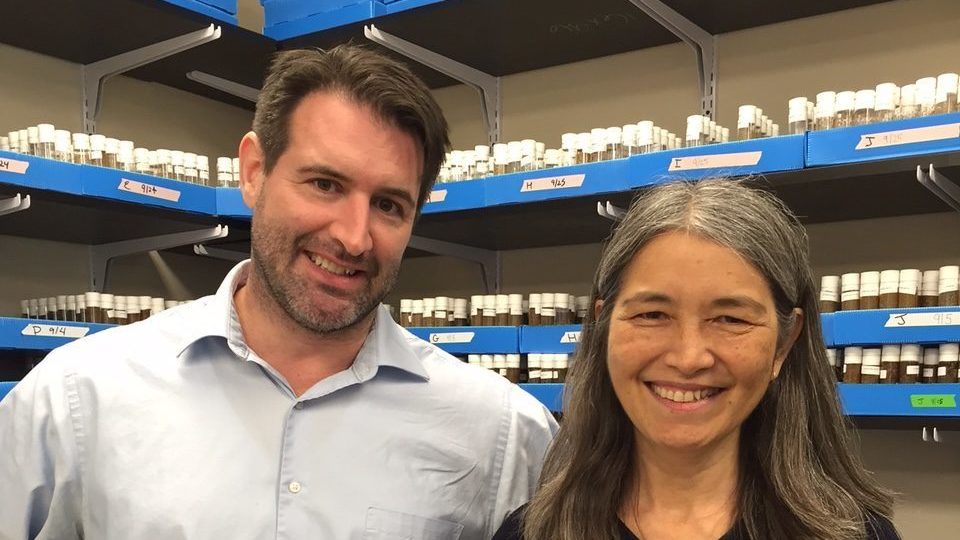Screening 2,320 FDA-Approved Drugs for Potential Treatment of Fragile X

Sean McBride, MD, PhD
Principal Investigator
Karen Joyce, DVM
FRAXA Fellow
Rowan University
Glassboro, NJ
2018-2021 Grant Funding: $90,000
Summary
FRAXA Research Foundation has awarded a $90,000 grant to Principal Investigator Dr. Sean McBride and Postdoctoral Fellow Dr. Karen Joyce, at Rowan University, to screen all 2,320 FDA-approved drugs in the fly model of Fragile X syndrome. Drugs which show promise will be tested in more detail for the potential to treat Fragile X syndrome in humans.
The Science
by Sean McBride, PhD, and Karen Rowan, DVM
Updated 2/4/2021
Our lab utilizes the model organism Drosophila melanogaster (fruit fly) to identify genes that can enhance or suppress social memory impairments in the Fragile X fly model. The protein products of these genes may be novel drug targets for treatment. We also use a long-term memory (LTM) paradigm that we developed previously to screen for molecules that can rescue LTM and social interaction.
In this project, using the fly model, we will perform an unbiased screen of 2,320 FDA-approved compounds. Unlike most Drosophila screens which use the eye phenotype or cell screens, we are testing the key phenotypes of interest, memory, and social interaction. Therefore, we are trading off speed of throughput in screening, to increase the specificity of identifying molecules that are effective in the fly model. Then, using the mouse model of Fragile X, we will test chronic treatment with the medications which show the most promise.
Fruit Flies as a Test Bed
Our lab motto is from flies to mice to clinic. For our basic science research we rely heavily on the fly (fruit fly, Drosophila) as a model to identify molecules to be advanced into the mouse model and ultimately clinical trials with critical support from the FRAXA Research Foundation. I think sometimes parents and to be honest other scientists don’t fully realize the potential of the fruit fly with regard to discovering treatments to improve the lives of individuals with intellectual disability and autism spectrum disorders, and specifically with Fragile X syndrome. In the fly model it was first demonstrated that mGluR antagonists, lithium, PDE-4 inhibitors and metformin could be potential treatments for FXS (McBride et al., 2005, Neuron; Choi et al., 2015, J of Neuroscience; Monyak at el., 2016, Molecular Psychiatry). Each of those strategies has and is continuing to be explored in clinical trials, including FRAXA funded trials of metformin and the recently completed study by Dr. Berry-Kravis demonstrating success in a Phase 2 trial of a PDE4D inhibitor. The importance of FRAXA’s funding for these studies cannot be over-stated.
As a basic scientist and a psychiatrist, Dr. McBride has long felt that the key to improving the lives of individuals with FXS and their families lies in developing an armamentarium of molecules that each have some efficacy and that could be utilized synergistically in combinatorial treatments. The development of this armamentarium is critical. Drosophila presents the perfect model system for the pharmacologic and genetic screen that we are performing to identify treatments to improve social interaction and cognition, which are the endpoints we utilize in our screen. Drosophila has exquisite conservation of the signaling involved in memory formation and circadian rhythms (the sleep-wake cycle).
Our current grant includes unbiased testing of all medications approved by the FDA and approved in Europe, as well as additional supplements and bioactive molecules. It is important to have a mixture of different compounds when considering repurposing medications or developing novel derivatives of current medications.
Screening Over 2000 FDA-Approved Available Compounds
Our fly screen is a little more labor intensive than traditional screens for 2 important reasons. First, in a traditional screen the outcome measure is something that can be done very quickly such as using lethality or eye texture. However, our interest is improving brain function to improve social interactions and cognition. Therefore we utilize social interaction and cognition as our outcome measurements. Second, we fine-tune the dose of each molecule in the screen according to the putative mechanism of action for that molecule. We feel that extra effort is worth it to provide higher quality results to advance forward for future studies.
As the fly screen progresses, we further investigate any compounds of interest with a full characterization that includes:
- testing multiple phases of memory
- attention
- sleep and circadian behavior
- neuro-anatomical phenotypes
- biochemistry and histology in the brain
- developmental efficacy
We prioritize characterizing positive hits in the fly model from the screen by looking at the molecules availability, ability to cross the blood brain barrier, and safety.
For any medication that looks promising in the fly, the next goal of our research is to advance to testing in the mouse model of Fragile X. So far during our screening project we have had a lot of molecules identified that play a role in normalizing cAMP signaling in the brain. We have been further exploring the efficacy of the mix of medications and supplements that cross the BBB and normalize cAMP signaling in order to be able to publish on the individual compounds. This would set the stage for other labs to independently advance these compounds in future studies of the Fragile X mouse model. True transformative discoveries for human disease go beyond identification of novel targets and begin testing in mammalian systems, so testing in the mouse
model is an important step toward Fragile X clinical trials.

